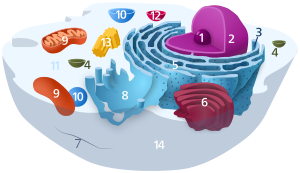Central vacuole
| Cell biology | |
|---|---|
| The animal cell | |

Components of a typical animal cell:
|
A vacuole (/ˈvækjuːoʊl/) is a membrane-bound organelle which is present in all plant and fungal cells and some protist, animal and bacterial cells. Vacuoles are essentially enclosed compartments which are filled with water containing inorganic and organic molecules including enzymes in solution, though in certain cases they may contain solids which have been engulfed. Vacuoles are formed by the fusion of multiple membrane vesicles and are effectively just larger forms of these. The organelle has no basic shape or size; its structure varies according to the needs of the cell.
The function and significance of vacuoles varies greatly according to the type of cell in which they are present, having much greater prominence in the cells of plants, fungi and certain protists than those of animals and bacteria. In general, the functions of the vacuole include:
Vacuoles also play a major role in autophagy, maintaining a balance between biogenesis (production) and degradation (or turnover), of many substances and cell structures in certain organisms. They also aid in the lysis and recycling of misfolded proteins that have begun to build up within the cell. Thomas Boller and others proposed that the vacuole participates in the destruction of invading bacteria and Robert B Mellor proposed organ-specific forms have a role in 'housing' symbiotic bacteria. In protists, vacuoles have the additional function of storing food which has been absorbed by the organism and assisting in the digestive and waste management process for the cell.
...
Wikipedia
